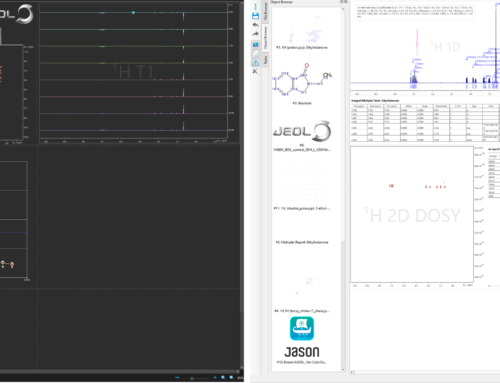Carefully selected apodization parameters can provide a welcome improvement to either the resolution or sensitivity of our NMR spectrum. Although apodization is one of the first data processing ‘tricks’ we learn in using NMR, getting the desired result is not always so simple and usually requires a degree of trial and error. In this blog post, I will show how the apodization slider tool in JASON 1.2 makes it quick and convenient to get the best out of our NMR data. This implementation allows us to focus on just what we need without reading pages of instructions and tips on selecting optimal apodization functions and their respective parameter definitions. The slider form represents our options to improve either resolution or sensitivity at the cost of the other one.
Using the Slider
After opening a 1D dataset, it is automatically processed in JASON by using the same apodization as was defined in the raw data file. We can overwrite these default apodization values in the Process tab. Apodization is most often the first item in our processing list, and we just need to expand the panel by clicking on the small arrow on the top right of the Apodization box. This takes us into ‘Basic mode’ where the assistance of the Apodization slider can be used.

Figure 1 The basic mode of Apodization in the Process tab.
Sensitivity vs Resolution
We can improve either the resolution or the sensitivity by moving the slider towards the left or right, respectively. The adjustment we make will not be immediately visible in the spectrum, but instead after we apply the new processing by clicking on the Apply button at the bottom right-hand corner of the Process tab.

Figure 2 Part of 1H NMR spectrum of a sample of 2-ethyl-1-indanone in CDCl3. The top (blue), middle (red), and bottom (green) spectra were processed by using default, best resolution and best sensitivity options of the Apodization slider. The default setting in this example uses an option which improves sensitivity marginally compared to not using any apodization.
In Figure 2, the same data were processed by using different options. The blue spectrum on the top is the result of automatic processing in JASON. In such cases, the apodization slider position is in the middle, reflecting that we haven’t made changes from the default values for these particular data. In most cases, the default option for a 1H NMR spectrum provides a marginal sensitivity improvement with respect to not using any apodization at all, but the actual values used are defined in our data acquisition protocol and are unlikely to be the best for our data. It is often beneficial to move the slider towards some resolution enhancement, provided we already have sufficient signal-to-noise in our 1H NMR spectrum.
Adjusting the Balance
One thing to keep in mind, though: the integral values of our signals can get distorted as we increase the extent of resolution enhancement. How far we can go will depend on our data. JASON uses a conservative approach, trying to ensure we never end up with too much resolution enhancement. This is important, not only because we degrade sensitivity in the process, but also because it can cause truncation artefacts which could confuse interpretation. Similarly, the scope for improving sensitivity will also depend on our data and, in this case, JASON uses an estimate of the average NMR linewidth across the full spectrum. The problem with ‘overdoing’ sensitivity improvement is usually less severe but can result in losing out on sensitivity in the extreme cases. This is because each line becomes slightly broader and lower in amplitude as we try to reduce the noise contribution in the spectrum, and there is naturally a point when the lowering of the amplitudes becomes more significant than the reduction in the noise level.
Digging Deeper
We can investigate what JASON decided to do by switching from ‘Basic mode’ to ‘Expert mode’. ‘Expert’ mode provides us with initialized values of the applied apodization functions and experienced users can specify parameter values here just like in any other software. The logic used by the JASON apodization slider is to apply what is commonly known as a Lorentz-to-Gauss transformation to improve resolution, and to apply a matched filter by exponential weighting to improve sensitivity. In both cases, JASON selects optimal parameters by taking into account the limitations imposed by our experimental acquisition time and the average decay rate of our NMR signal.

